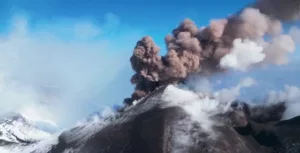Mount Etna, Europe’s tallest and most active volcano, has once again captured the world’s attention with a spectacular eruption. Towering at approximately 3,300 meters (10,800 feet), the volcano unleashed plumes of smoke and rivers of lava from its newly active “Bocca Nuova” crater. This breathtaking natural event offers a stunning reminder of Earth’s raw power. Here’s everything you need to know about the eruption, its significance, and how to witness this awe-inspiring phenomenon.
What Happened During the Eruption?
Smoke and Lava Light Up the Sky
- Bocca Nuova Crater: The eruption originated from this newly active crater, sending thick plumes of smoke high into the atmosphere.
- Lava Flows: Fiery lava cascaded down the volcano’s slopes, creating a dramatic visual spectacle.
- Height of Activity: Mount Etna’s eruptions are frequent, but this event stands out for its intensity and visibility.
Impact on Surrounding Areas
- Air Travel: Flights in the region were temporarily disrupted due to ash clouds, though no major cancellations were reported.
- Local Communities: Residents near the volcano are accustomed to its activity, but authorities remain vigilant for any sudden changes.
Why is Mount Etna So Active?
A Geologically Dynamic Region
- Mount Etna is located on the island of Sicily, Italy, where the African and Eurasian tectonic plates meet, creating a hotspot for volcanic activity.
- It is one of the world’s most active volcanoes, with eruptions recorded as far back as 1500 BCE.
A UNESCO World Heritage Site
- Recognized for its scientific and cultural significance, Mount Etna attracts researchers, tourists, and photographers from around the globe.
How to Safely Witness the Eruption
Best Viewing Spots
- Rifugio Sapienza: A popular tourist hub offering panoramic views of the volcano.
- Zafferana Etnea: A nearby town known for its clear vantage points and charming atmosphere.
Guided Tours
- Local tour operators offer guided hikes and jeep tours, ensuring safety while providing expert insights into the volcano’s history and activity.
The Science Behind the Spectacle
Volcanic Eruptions Explained
- Eruptions occur when magma from beneath the Earth’s crust rises to the surface, releasing gases, ash, and lava.
- Mount Etna’s eruptions are primarily strombolian, characterized by explosive bursts and lava flows.
Monitoring and Research
- Scientists use advanced technology, including drones and satellites, to monitor Etna’s activity and predict future eruptions.
Conclusion
Mount Etna’s latest eruption is a powerful reminder of nature’s beauty and unpredictability. Whether you’re a science enthusiast, a photographer, or simply a curious traveler, witnessing this event is an unforgettable experience. Stay updated on safety guidelines and plan your visit to see one of the world’s most iconic volcanoes in action.
References:
- BBC News
- UNESCO World Heritage Centre
- National Geographic
















